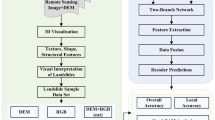Abstract
With the analysis of the characteristics of back propagation neural network (BPNN) and map generalization of building outlines in both urban and suburban areas, a new approach that is based on local perception of map contexts for building aggregation has been studied. The method called the local perception-based intelligent building outline aggregation approach with BPNN technique consisted of two BPNNs. \(\text {BPNN}_{1}\) was developed to generate initial aggregated building outlines. A circular detector coupled with a set of mapping rules was designed to detect buildings from raster maps. Once trained, \(\text {BPNN}_{1}\) produced initial aggregated building outlines. Due to the existence of unwanted nodes forming small steps along the outlines, \(\text {BPNN}_{2}\) was created to remove the unwanted ones. Here, a square detector was designed and a set of refining rules formulated. Together, \(\text {BPNN}_{1}\) and \(\text {BPNN}_{2}\) intelligently delineated individual buildings or a group of buildings. The performance of the approach has been assessed and the generalized results were cartographically satisfactory.



















Similar content being viewed by others
References
ICA (International Cartographic Association) (1973) Multilingual dictionary of technical terms in cartography. Franz Steiner Verlag GmbH, Wiesbaden, Germany 573 p
Li Z, Yan H, Ai T, Chen J (2004) Automated building generalization based on urban morphology and gestalt theory. Int J Geogr Inf Sci 18(5):513–534
Peng W (1997) Automatic generalization in GIS. ITC Publication Series, Enschede
Wu HH (2000) Problems of city plan generalization in the GIS environment. J Wuhan Tech Univ Surv Mapp 25(3):196–202
Qian HZ, Wu F (2001) A merge operation for area objects based on Delaunay triangle-interpolating. J Inst Surv Mapp 18(3):207–209
Regnauld N (1996) Recognition of building cluster for generalization. Proceedings of the 7th international symposium on spatial data handling (SDH’96), pp 185–198
Ai TH, Guo RZ, Chen XD (2001) Simplification and aggregation of polygon object supported by Delaunay triangulation structure. J Image Gr 6A(7)” 703–709
Ai TH, Guo RZ (2002) A constrained Delaunay partitioning of areal objects to support map generalization. J Wuhan Techn Univ Surv Mapp 25(1):35–41
Ruas A (1995) Multiple paradigms for automating map generalization: geometry, topology, hierarchical partitioning and local triangulation. American Congress on Surveying and Mapping, American Society for Photogrammetry and Remote Sensing (ACSM /ASPRS’95) AutoCarto 12, pp 69–78
Ware JM, Jones CB (1996) A spatial model for detecting (and resolving) conflict caused by scale reduction. Proceedings of the 7th international symposium on spatial data handling (SDH’96), pp 547–558
Qian HZ, Wu F, Tan X, Deng HY (2005) The algorithm for merging city buildings based on ABTM. J Image Gr 10(10):1224–1233
Zhang J, Zhou Y, Liu Y (2006) An improved algorithm for SDS model based polygon simplification and aggregation. J Image Gr 11(7):1011–1016
Meng L (1997) Automatic generalization of geographic data [online]. Technical Report, VBB Viak, Stockholm, Sweden. Available from: http://portal.survey.ntua.gr/main/courses/geoinfo/admcarto/lecture_notes/generalisation/bibliography/meng_1997.pdf. Accessed July 2012
Li J, Zheng SY, Zhang ZX, Yu H, Liu JB (2005) Buildings generalization based on mathematical morphology. Proceeding of the society for optical engineering (SPIE 2005), MIPPR 2005: SAR and Multispectral Image Processing 6043, pp 372–377
Guo RZ, Ai TH (2000) Simplification and aggregation of building polygon in automatic map generalization. J Wuhan Techn Univ Surv Mapp 25(1):25–30
Ware JM (2003) Automated map generalization with multiple operators: a simulated annealing approach. Int J Geogr Inform Sci 17(8):743–769
Jiang B, Harrie L (2004) Selection of streets from a network using self-organizing map. Trans GIS 8(3):335–350
Allouche MK, Moulin B (2005) Amalgamation in cartographic generalization using Kohonen’s feature nets. Int J Geogr Inform Sci 19(8–9):899–914
Steiniger S, Taillandier P, Weibel R (2010) Utilising urban context recognition and machine learning to improve the generalisation of buildings. Int J Geogr Inform Sci 24(2):253–282
Su B, Li Z, Lodwick G, Mulier J (1997) Algebraic models for the aggregation of area features based upon morphological operators. Int J Geogr Inform Sci 11(3):233–246
Lek S, Guégan JF (1999) Artificial neural networks as a tool in ecological modelling, an introduction. Ecol Model 120:65–73
Sukthankar R, Pomerleau D, Thorpe C (1993) Panacea: an active sensor controller for the ALVINN autonomous driving system. Technical Report CMU-RI-TR-93-09, Robotics Institute (NAVLAB), Pittsburgh Carnegie Mellon University
Wang HL, Wu F, Zhang LL, Deng HY (2005) The application of mathematical morphology and pattern recognition to building polygon simplification. Acta Geodaetica et Cartographica Sinica 34(3):269–276
Basaraner M, Selcuk M (2008) A structure recognition technique in contextual generalisation of buildings and built-up areas. Cartogr J 45(4):274–285
Pawlus W, Karimi HR, Robbersmyr KG (2013) Data-based modeling of vehicle collisions by nonlinear autoregressive model and feedforward neural network. Inform Sci 235:65–79
Karimi HR, Robbersmyr KG (2011) Signal analysis and performance evaluation of a vehicle crash test with a fixed safety barrier based on Haar wavelets. Int J Wavel Multiresolout Image Process 9(1):131–149
Gao ZS, Shi P, Karimi HR, Pei Z (2013) A mutual GrabCut method to solve co-segmentation. EURASIP J Image Video Process 2013: 20
Acknowledgments
This research was partially funded by the National Natural Science Foundation of China under Grant No. 41071222 to the University of Electronic Science and Technology, China.
Author information
Authors and Affiliations
Corresponding author
Rights and permissions
About this article
Cite this article
Cheng, B., Liu, Q. & Li, X. Local Perception-Based Intelligent Building Outline Aggregation Approach with Back Propagation Neural Network. Neural Process Lett 41, 273–292 (2015). https://doi.org/10.1007/s11063-014-9345-x
Published:
Issue Date:
DOI: https://doi.org/10.1007/s11063-014-9345-x




